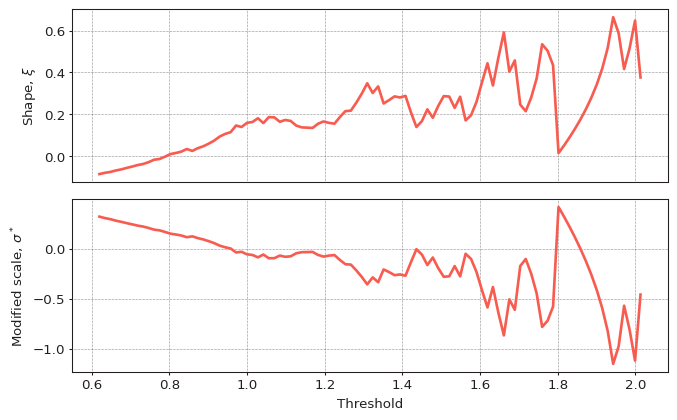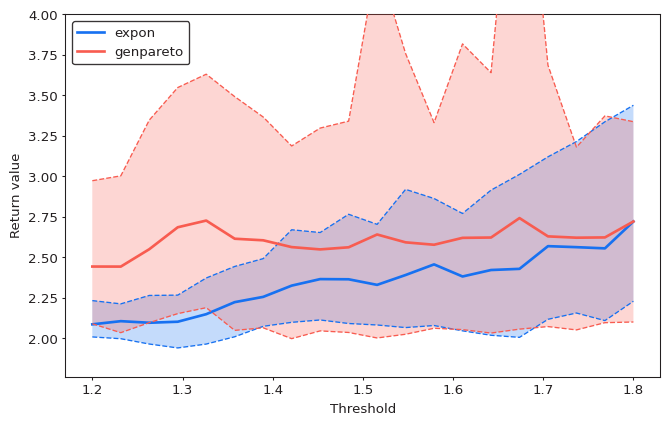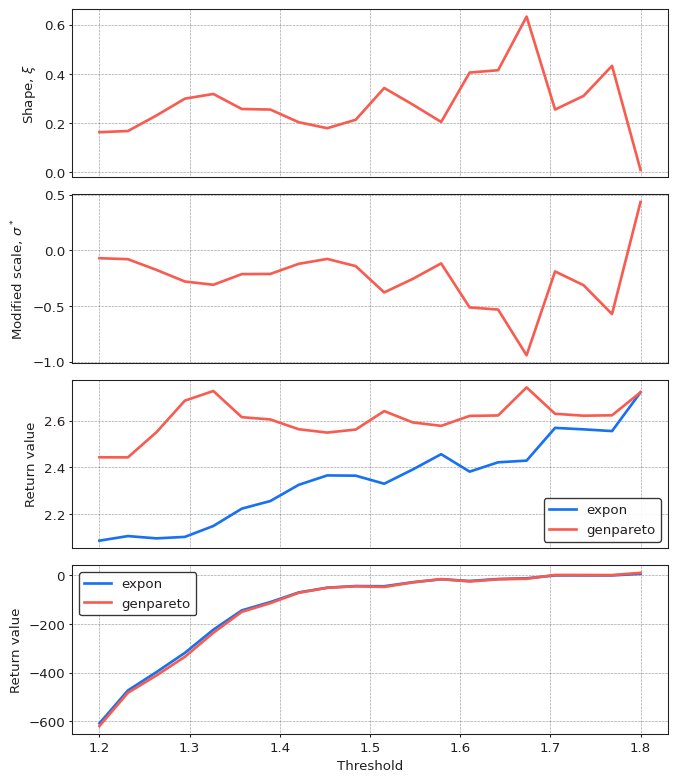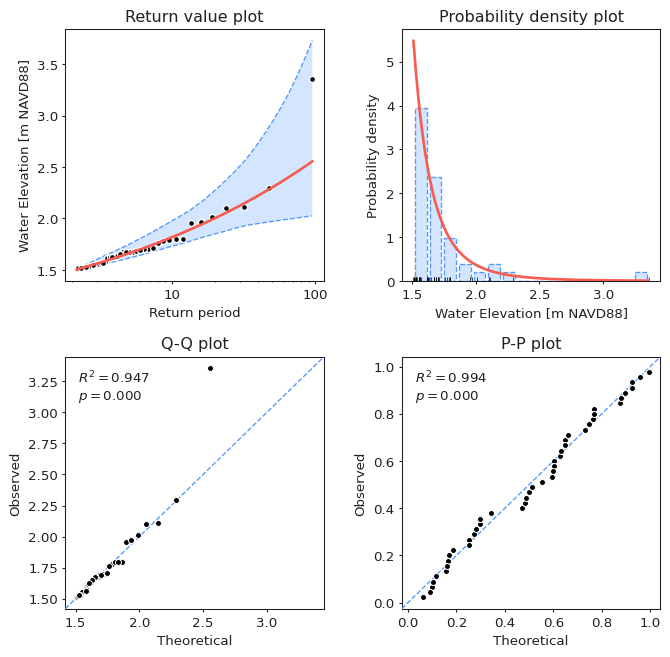Threshold Selection
Selection of the threshold value is a very important step because it has the strongest
effect on the results of EVA. The core idea of threshold selection is the same as when
selecting block size in the Block Maxima approach - it is a trade-off between bias
and variance. Larger threshold values produce few extreme values and lead to large
variance in result (confidence bounds), while smaller threshold values generate a sample
which poorly approximates the GPD model. The opposite is true when performing EVA
for extreme low values (extremes_type="low").
The key goal of threshold selection can, therefore, be formulated as follows:
Goal of threshold selection
Select the smallest threshold value among those which produce extreme values following the limit exceedance model (Generalized Pareto Distribution family).
Warning
Threshold selection is probably the hardest part of Extreme Value Analysis when analyzing extreme values obtained using the Peaks Over Threshold method. It involves a great deal of subjective judgement and should be performed in conjunction with other methods, such as Block Maxima + GEVD, to gain more confidence in the validty of obtained results.
Mean Residual Life¶
Mean residual life plot plots average excess value over given threshold for a series of thresholds. The idea is that the mean residual life plot should be approximately linear above a threshold for which the Generalized Pareto Distribution model is valid.
from pyextremes import plot_mean_residual_life
plot_mean_residual_life(data)

Note
You can get the data variable referenced above by running the following code:
data = pd.read_csv(
"battery_wl.csv",
index_col=0,
parse_dates=True,
).squeeze()
data = (
data
.sort_index(ascending=True)
.astype(float)
.dropna()
.loc[pd.to_datetime("1925"):]
)
data = (
data - (data.index.array - pd.to_datetime("1992"))
) / pd.to_timedelta("365.2425D") * 2.87e-3
"battery_wl.csv"
can be downloaded here.
All figures shown in this tutorial section were generated using this jupyter notebook.
As seen in the figure above, exceedance values are approximately linear between threshold values of 1.2 and 1.8. This provides a range of threshold values which can be further investigated using other methods.
The plot_mean_residual_life function uses the following parameters:
- ts - time series (
pandas.Series) from which the extreme values are extracted - thresholds - array of threshold for which the plot is displayed. By default
100 equally-spaced thresholds between 90th (10th if
extremes_type="high") percentile and 10th largest (smallest ifextremes_type="low") value in the series. - extremes_type - extreme value type:
"high"for above threshold (default) and"low"for below threshold. - alpha - confidence interval width in the range (0, 1), by default it is 0.95. If None, then confidence interval is not shown.
- ax - matplotlib Axes object. If provided, then the plot is drawn on this axes. If None (default), new figure and axes are created
- figsize - figure size in inches in format (width, height). By default it is (8, 5).
Note
In author's (subjective) opinion this is the least useful technique among those listed in this section because mean residual life plots are very hard to interpret.
Parameter Stability¶
Parameter stability plot shows how shape and modified scale parameters of the Generalized Pareto Distribution change over a range of threshold values. The idea is that these parameters should be stable (vary by small amount) within a range of valid thresholds.
from pyextremes import plot_parameter_stability
plot_parameter_stability(data)

As seen in the figure above, these parameters appear to stabilize around threshold value of 1.2 with subsequent values having higher variance due to smaller number of exceedances.
The plot_parameter_stability function uses the following parameters:
- ts - time series (
pandas.Series) from which the extreme values are extracted - thresholds - array of threshold for which the plot is displayed. By default
100 equally-spaced thresholds between 90th (10th if
extremes_type="high") percentile and 10th largest (smallest ifextremes_type="low") value in the series. - r - minimum time distance (window duration) between adjacent clusters. Used
to decluster exceedances by locating clusters where all exceedances are separated
by distances no more than
rand then locating maximum or minimum (depends onextremes_type) values within each cluster. By defaultr="24h"(24 hours). - extremes_type - extreme value type:
"high"for above threshold (default) and"low"for below threshold. - alpha - confidence interval width in the range (0, 1), by default it is 0.95. If None, then confidence interval is not shown.
- n_samples - number of bootstrap samples used to estimate confidence
interval bounds (default=100). Ignored if
alphais None. - axes - tuple with matplotlib Axes (ax_shape, ax_scale) for shape and scale values. If None (default), new figure and axes are created.
- figsize - figure size in inches in format (width, height). By default it is (8, 5).
- progress - if True, shows tqdm progress bar. By default False.
Requires
tqdmpackage.
Return Value Stability¶
An extension of the previous technique is to investigate stability of a target return value with a pre-defined return period over a range of thresholds. This technique provides a more intuitive metric of model stability. Let's plot it for the range of thresholds identified earlier:
from pyextremes import plot_return_value_stability
plot_return_value_stability(
data,
return_period=100,
thresholds=np.linspace(1.2, 1.8, 20),
alpha=0.95,
)

As seen in the figure above, the model is very stable for threshold values above 1.4.
The plot_return_value_stability function uses the following parameters:
- ts - time series (
pandas.Series) from which the extreme values are extracted - return_period - return period given as a multiple of
return_period_size. - return_period_size - size of return period. Same as the
rargument. By default this is 1 year. - thresholds - array of threshold for which the plot is displayed. By default
100 equally-spaced thresholds between 90th (10th if
extremes_type="high") percentile and 10th largest (smallest ifextremes_type="low") value in the series. - r - minimum time distance (window duration) between adjacent clusters. Used
to decluster exceedances by locating clusters where all exceedances are separated
by distances no more than
rand then locating maximum or minimum (depends onextremes_type) values within each cluster. By defaultr="24h"(24 hours). - extremes_type - extreme value type:
"high"for above threshold (default) and"low"for below threshold. - distributions - list of distributions for which the plot is produced.
By default these are "genpareto" and "expon".
A distribution must be either a name of distribution from
scipy.statsor a subclass of scipy.stats.rv_continuous. See scipy.stats documentation - alpha - confidence interval width in the range (0, 1), by default it is 0.95. If None, then confidence interval is not shown.
- n_samples - number of bootstrap samples used to estimate confidence
interval bounds (default=100). Ignored if
alphais None. - ax - matplotlib Axes object. If provided, then the plot is drawn on this axes. If None (default), new figure and axes are created
- figsize - figure size in inches in format (width, height). By default it is (8, 5).
- progress - if True, shows tqdm progress bar. By default False.
Requires
tqdmpackage.
Warning
This is the most dangerous threshold selection technique presented in this section. It can be abused by selecting a threshold value which gives a desired result. Results of such analysis would be biased and invalid. Analysts should honestly present results of their analysis and high variance in answer should be considered a valuable result as well - it indicates that available data can be used to obtain reliable results and that there is high uncertainty in the analyzed process.
Putting it all Together¶
pyextremes provides a convenience function to put all of the above together.
It also adds an additional plot - AIC curve indicating relative model performance.
The AIC curve should not be used as a threshold selection tool because it will always
have the same logarithmic shape. Instead, it should guide the user as to which model
(e.g. GEVD or Exponential) should be preferred for a given threshold.
from pyextremes import plot_threshold_stability
plot_threshold_stability(
data,
return_period=100,
thresholds=np.linspace(1.2, 1.8, 20),
)

Based on the figures shown earlier, one may conclude that the valid threshold may lie between 1.4 and 1.6. A decision was made to select threshold value of 1.5.
The plot_threshold_stability function uses the following parameters:
- ts - time series (
pandas.Series) from which the extreme values are extracted - return_period - return period given as a multiple of
return_period_size. - return_period_size - size of return period. Same as the
rargument. By default this is 1 year. - thresholds - array of threshold for which the plot is displayed. By default
100 equally-spaced thresholds between 90th (10th if
extremes_type="high") percentile and 10th largest (smallest ifextremes_type="low") value in the series. - r - minimum time distance (window duration) between adjacent clusters. Used
to decluster exceedances by locating clusters where all exceedances are separated
by distances no more than
rand then locating maximum or minimum (depends onextremes_type) values within each cluster. By defaultr="24h"(24 hours). - extremes_type - extreme value type:
"high"for above threshold (default) and"low"for below threshold. - distributions - list of distributions for which the plot is produced.
By default these are "genpareto" and "expon".
A distribution must be either a name of distribution from
scipy.statsor a subclass of scipy.stats.rv_continuous. See scipy.stats documentation - alpha - confidence interval width in the range (0, 1), by default it is 0.95. If None, then confidence interval is not shown.
- n_samples - number of bootstrap samples used to estimate confidence
interval bounds (default=100). Ignored if
alphais None. - ax - matplotlib Axes object. If provided, then the plot is drawn on this axes. If None (default), new figure and axes are created
- figsize - figure size in inches in format (width, height). By default it is (8, 5).
- progress - if True, shows tqdm progress bar. By default False.
Requires
tqdmpackage.
Results of selecting the threshold value 1.5 are shown below:
